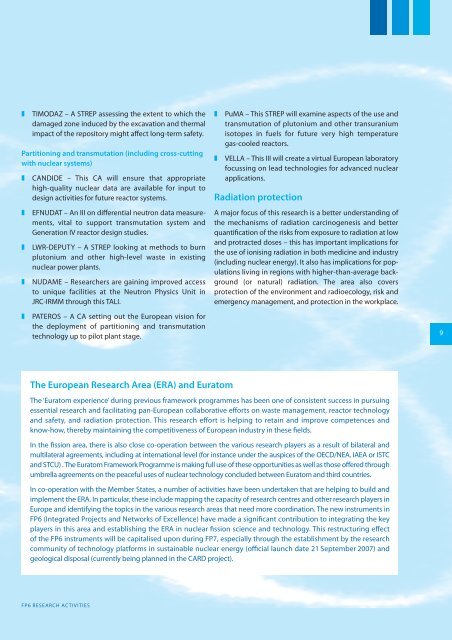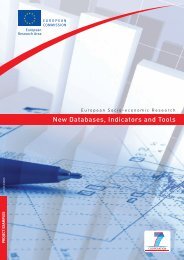Euratom FP6 Research Projects and Training Activities Volume III
Euratom FP6 Research Projects and Training Activities Volume III
Euratom FP6 Research Projects and Training Activities Volume III
Create successful ePaper yourself
Turn your PDF publications into a flip-book with our unique Google optimized e-Paper software.
❚ TIMODAZ – A STREP assessing the extent to which the<br />
damaged zone induced by the excavation <strong>and</strong> thermal<br />
impact of the repository might affect long-term safety.<br />
Partitioning <strong>and</strong> transmutation (including cross-cutting<br />
with nuclear systems)<br />
❚ CANDIDE – This CA will ensure that appropriate<br />
high-quality nuclear data are available for input to<br />
design activities for future reactor systems.<br />
❚ EFNUDAT – An <strong>III</strong> on differential neutron data measurements,<br />
vital to support transmutation system <strong>and</strong><br />
Generation IV reactor design studies.<br />
❚ LWR-DEPUTY – A STREP looking at methods to burn<br />
plutonium <strong>and</strong> other high-level waste in existing<br />
nuclear power plants.<br />
❚ NUDAME – <strong>Research</strong>ers are gaining improved access<br />
to unique facilities at the Neutron Physics Unit in<br />
JRC-IRMM through this TALI.<br />
❚ PATEROS – A CA setting out the European vision for<br />
the deployment of partitioning <strong>and</strong> transmutation<br />
technology up to pilot plant stage.<br />
The European <strong>Research</strong> Area (ERA) <strong>and</strong> <strong>Euratom</strong><br />
<strong>FP6</strong> RESEARCH ACTIVITIES<br />
❚ PuMA – This STREP will examine aspects of the use <strong>and</strong><br />
transmutation of plutonium <strong>and</strong> other transuranium<br />
isotopes in fuels for future very high temperature<br />
gas-cooled reactors.<br />
❚ VELLA – This <strong>III</strong> will create a virtual European laboratory<br />
focussing on lead technologies for advanced nuclear<br />
applications.<br />
Radiation protection<br />
A major focus of this research is a better underst<strong>and</strong>ing of<br />
the mechanisms of radiation carcinogenesis <strong>and</strong> better<br />
quantification of the risks from exposure to radiation at low<br />
<strong>and</strong> protracted doses – this has important implications for<br />
the use of ionising radiation in both medicine <strong>and</strong> industry<br />
(including nuclear energy). It also has implications for populations<br />
living in regions with higher-than-average background<br />
(or natural) radiation. The area also covers<br />
protection of the environment <strong>and</strong> radioecology, risk <strong>and</strong><br />
emergency management, <strong>and</strong> protection in the workplace.<br />
The ‘<strong>Euratom</strong> experience’ during previous framework programmes has been one of consistent success in pursuing<br />
essential research <strong>and</strong> facilitating pan-European collaborative efforts on waste management, reactor technology<br />
<strong>and</strong> safety, <strong>and</strong> radiation protection. This research effort is helping to retain <strong>and</strong> improve competences <strong>and</strong><br />
know-how, thereby maintaining the competitiveness of European industry in these fields.<br />
In the fission area, there is also close co-operation between the various research players as a result of bilateral <strong>and</strong><br />
multilateral agreements, including at international level (for instance under the auspices of the OECD/NEA, IAEA or ISTC<br />
<strong>and</strong> STCU) . The <strong>Euratom</strong> Framework Programme is making full use of these opportunities as well as those offered through<br />
umbrella agreements on the peaceful uses of nuclear technology concluded between <strong>Euratom</strong> <strong>and</strong> third countries.<br />
In co-operation with the Member States, a number of activities have been undertaken that are helping to build <strong>and</strong><br />
implement the ERA. In particular, these include mapping the capacity of research centres <strong>and</strong> other research players in<br />
Europe <strong>and</strong> identifying the topics in the various research areas that need more coordination. The new instruments in<br />
<strong>FP6</strong> (Integrated <strong>Projects</strong> <strong>and</strong> Networks of Excellence) have made a significant contribution to integrating the key<br />
players in this area <strong>and</strong> establishing the ERA in nuclear fission science <strong>and</strong> technology. This restructuring effect<br />
of the <strong>FP6</strong> instruments will be capitalised upon during FP7, especially through the establishment by the research<br />
community of technology platforms in sustainable nuclear energy (official launch date 21 September 2007) <strong>and</strong><br />
geological disposal (currently being planned in the CARD project).<br />
9



